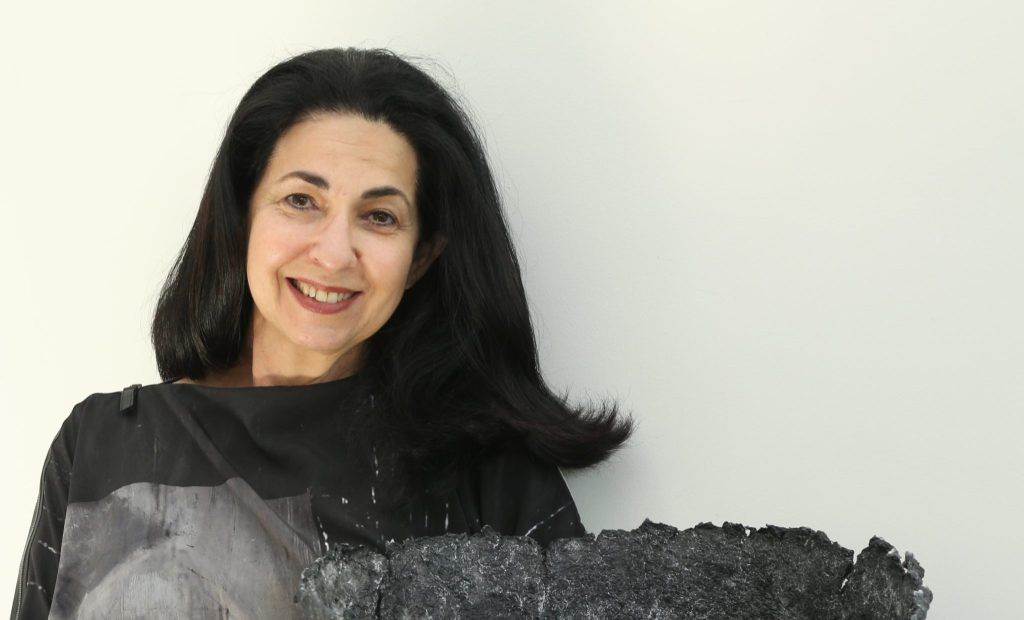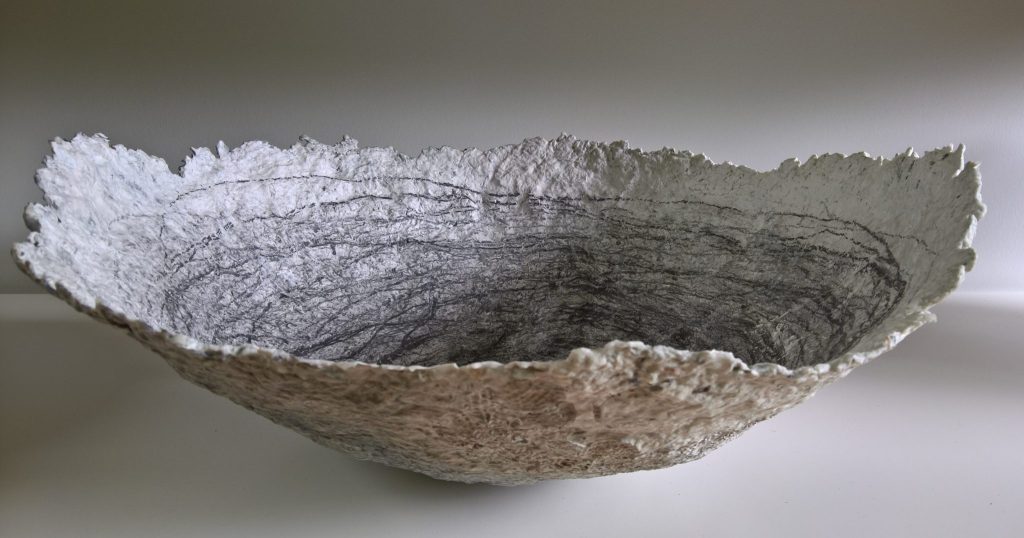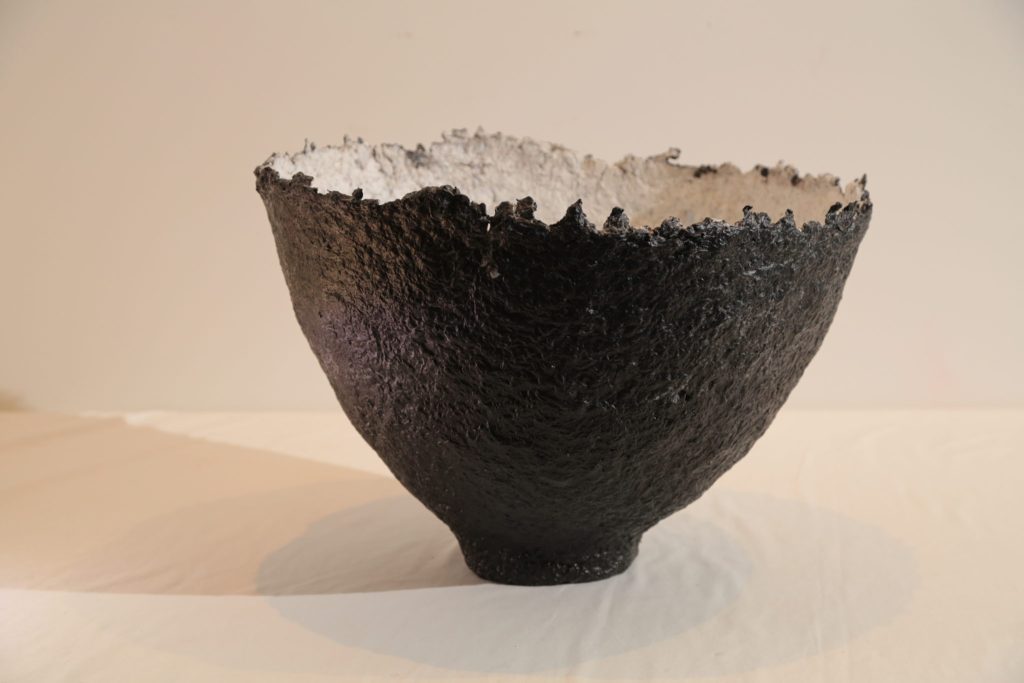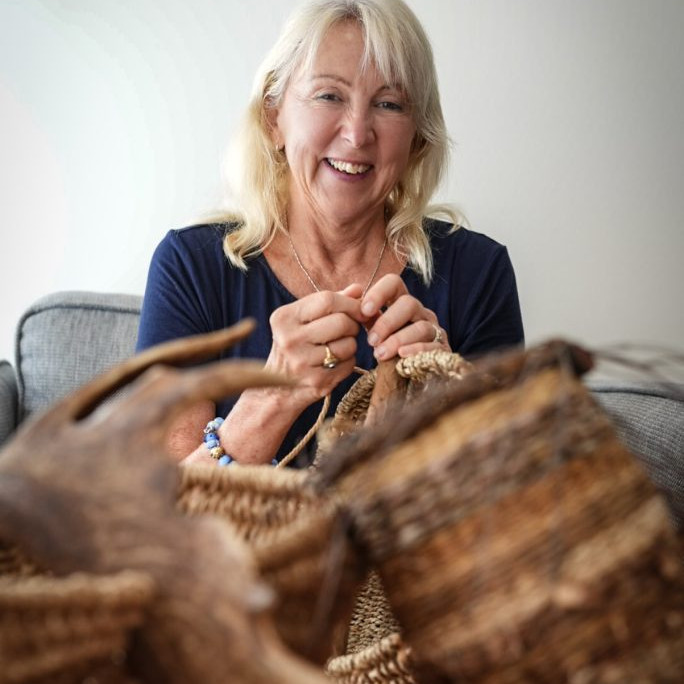Ruth Levine Mixed Medium - Sydney, Australia
Your art is about visual transformation of materials, discuss.
I’m not intentionally an eco-artist. I see discarded and new materials in a transformational way.
I synergise unrelated materials and thoughts into a new form.
What was it about Cradle Mountain in Tasmania, Australia that lead to a burst of creativity in you?
My ‘light globe moment’ happened at Cradle Mountain in awe of the King Billy Pine, so old, so magnificent: a symbol of survival. This became ‘the thought’
Returning to Sydney, my sons empty fruit juice bottles seemed to be congregating on the drainer and not making their way into the recycle bin. That particular brand’s bottle (‘the material’), inspired the possibility of totems and the idea of using discarded man-made objects into urban trees.
At the time, I had started experimenting with transferring photos of my textures onto canvas.
Textures of King Billy wrapped the stacked, glued fruit juice bottles and became the start of my totems: urban trees.
Ode to King Billy, 1720 x120 dia, 1620 x 120 dia ,1550 x 120 dia
The urban trees are now memory trees with images relating to places travelled and experienced.
They are mounted on a block of hardwood with a central steel rod, the base bottles are filled with concrete and wrapped in canvas or recycled denim then the surface patterning applied onto strips of recycled or unloved fabric and sealed.
Explain about your bowls, Brown paper nest bowls and Phoenix black bowls.
Wastage exists as a by-product of design and building.
With wastage I see inspiration.
From the Office:
The dreaded 5 year old paper archives (meetings, accounts, projects, forms, timesheets, contracts), shredded, soaked, mulched, combined with impasto medium and manipulated over moulds into bowls, platters and shields.
Pheonix- crater grey and charcoal bowl 630 x 600 x 230
I call this series Phoenix: Out of destruction comes beauty.
Its left in its natural/ grey white paper or painted, stained, applied with charcoal, string or imbedded with recycled aluminium coffee pod lids. They are strong, confusing the eye as to the weight and nature of the material, is it stone? Concrete? Ceramic?
Phoenix large black and white bowl 440 dia x 300
From the home, leftover scraps of fabric from new furnishings, old bedding, sheets, pillow cases, Jeans, T shirts, linen, string and spent Nespresso coffee pods.
George Collection bowl with Yarra River Flats paint details
(made from the contents of spent coffee pods) 320 x 280 x 40
Explain your personal relationship with totems?
From the building site I reuse concrete core holes (these are holes that are cut out of the concrete slab to allow for plumbing and services). The bits of iron and stone in the aggregate of the concrete is quite beautiful when polished up. I use these for my mini totems. Extending the concrete with cut up pet bottles, canvas, cotton, string.
Urban Wilderness – a group of 5 mini totems
Where is your studio?
I have a beautiful studio built up top of the double garage by my very considerate and patient partner! It’s near Centennial Park in Sydney. It’s white, bright, airy with large windows and a sky light. I work on a few pieces at a time as the works are process driven with drying time between layers. As an artist I am messy, I think that’s the nature of this type of work. I spread out and have long tables (yes recycled catering tables!) there is order in the chaos and I group different type of materials together and categorise the strips and cuts of leftover fabrics.
The best part is an enormous IKEA kitchen sink where I can soak the fabric prior to rubbing of the backing paper from the photocopies of the textures.
Storage of finished art is not an issue as it makes its way temporarily into my home or straight to an exhibition.
Moorish black denim bowl 220 dia x 170
How does your work as an Interior Designer influenced your art pieces?
I love textiles, textures, the balancing of clean lines with a handmade object in an interior. It’s usually one of the reasons people say, this room ’feels good’, the eye sees texture and the hand feels the texture.
The handmade object brings heart and history to an otherwise new living space creating an emotional balance. Perfection balanced with imperfection. Interior design is mostly about creating perfect spaces for Clients. The imperfection is the balance for my needs as a designer and artist.
StudioLEVINE resulted from my passion for design as an interior designer.
When a piece is purchased do you explain the material used and how to care for the piece?
When I sell pieces they are sent off with ‘adoption papers’- with care instructions! I love receiving photos of the vessels in their new homes.
What are you currently working on?
For February 2017, a new collection for Spence and Lyda, a beautiful and ethical furniture showroom in Sydney’s Surry Hills.
Also an exciting, combined exhibition ‘Synaesthesia’ July 7-21 2017, in Sydney’s Botanical Garden, The Palm House with painter Juliet Holmes a Court with and inspired by the poetic writings of Paolo Totaro. Paolo will be launching his new book featuring photos of Juliet’s paintings and my vessels. We are in the embryonic stages of planning and its taking my intellectual + creative energy to a new level.
Contact details
Ruth Levine
Sydney: Spence and Lyda, Surry Hills
Melbourne: Fanuli Melbourne, South Yarra
studiolevine.com
Ruth Levine, Sydney, Australia
Interview by Deborah Blakeley, January, 2017
Think a colleague or friend could benefit from this interview?
Knowledge is one of the biggest assets in any business. So why not forward this on to your friends and colleagues so they too can start taking advantage of the insightful information the artist has given?
Other artists you may be interested in:













